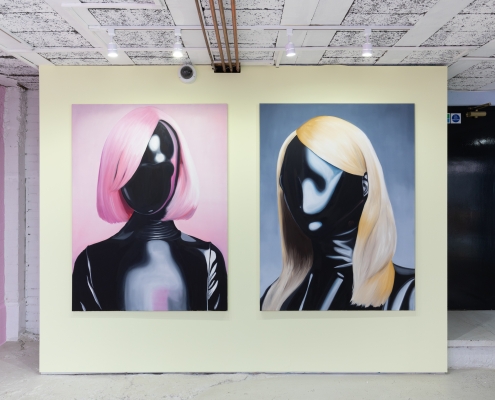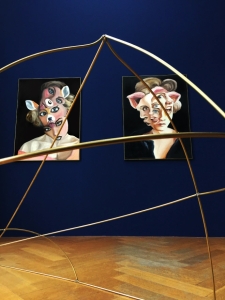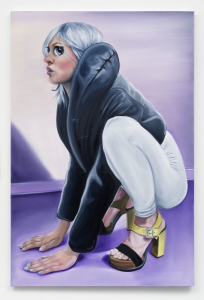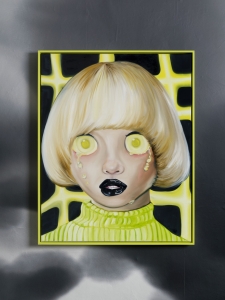Recent Exhibitions
Virtually Yours
 KH Gallery, LONDON 2023
KH Gallery, LONDON 2023
‘Can you fall in love with a thing, a robot, a photograph?’
Black latex gloves, wide-eyed doll-like figures, garlands of roses, pink oozing forms. Charlie Stein’s art plays on the language of seduction, fetish and digital realms to explore the boundaries between reality and the imagination, the self and the other. Virtually Yours, the artist’s first solo exhibition at Kristin Hjellegjerde Gallery, comprises a provocative new series of paintings that consider the ways in which we articulate emotion and form attachments.
Study for a Museum Display
 Villa Merkel, 2017
Villa Merkel, 2017
At first glance Charlie Stein’s paintings hail from the context of Selfie Culture,the
staging of the individual in social networks.
»To live is also to pose« (1) is how Susan Sontag described the urge for self-
expression which Isabelle Graw exposed as the »pressure to perform oneself« (2)
by pointing to the traces of everything that was not supposed to be immediately visible:
»What remains hidden is their fears: the fear of losing one’s social position, the fear of
not succeeding, the fear of an unpredictable, insecure future and the fear that someone
might discover that we are not competent after all« (3).
The viewer’s somewhat shameful wariness when looking at the almost thirty portraits
executed for the exhibition »Study for a Museum Display« also hails from their striking
immediacy, since all of them originated from digitally edited collages of self-portraits of
the artist herself, which are now posing in the traditional medium of oil painting, in the
safe zone of a salon setting.
Unimate
 Unimate, 2020
Unimate, 2020
The image of the automobile has long been a site for unconscious human desire. Sexuality, luxury and danger are combined with more utilitarian promises, like motion and freedom. In her first solo show at Smac, Charlie Stein presents an insight into her world: in which female robots look disenchantedly at their observers, they hijack cars, or they simply hang out with other robots. However they are positioned between different junctures and fault lines in contemporary culture.
Flow My Tears
 Flow My Tears, 2022
Flow My Tears, 2022
Flow My Tears comes from a Philip K Dick novel, which in turn echoes the title of a piece of music composed in the 16th century by John Dowland. While very different media, both Dick’s novel and Dowland’s composition delve the depths of loss specific to this mortal coil and reveal a new psychological landscape—a reality transcending what is typically thought humanly possible.
Amerika
White Heat – Charlie Stein‘s Amerika
Oberwelt, 2018
Amerika marks a new body of work by artist Charlie Stein, and is a complex and historical response to today’s fluid nature of self-identity. Her paintings hung in a silver environment, and french fry sculpture, both revel in, and interrogate, the constructed nature of iconic American flag imagery.
Drawn from a variety of photographic sources, Stein’s painting subjects are individuals wea- ring the American flag for divergent purposes. Music stars, European models, nationalists, and high school students on summer break are hung with equal status, in dialogue with one ano- ther. Often subtly desaturated, both wearer and flag have a kind of historical distance. These familiar images in their newly unstrident form manage to invoke a sense of subtle anxiety.
In Grey American Flag (1960), Jasper Johns drained the American flag of color, revealing both its status as formal object, and the inherent flatness of the picture plane. Andy Warhol would later reduce American icons, in work such as Double Elvis (1963), into similarly flat visual surfaces. The uses of a flag are usually at odds with subtlety. What does it mean when such a symbol, attached to one’s personal identity, is drained of its power?
As a German artist, Stein presents us with a unique take on the type of resurgent nationalism that is seen across the world today. The artist spent time at a high school in America, and she has maintained important artistic connections with New York throughout her career. Stein is not alone with these types of personal connections – America during the 1980s was an important cultural reference point for many Germans. And whilst America’s strident display of patriotism may seem foreign to a post-war European audience, it has the complex additional readings of nostalgia and personal autobiography.
Within the United States today, patriotic sym-
bols have been given a similarly complex and contradictory status. One particular example is the protest method chosen by NFL players led by Colin Kaepernick of kneeling during the national anthem, to protest police brutality. This simple act grew out of an interplay of contrasting codes, drawn equally from civil rights movements and military protocol (kneeling by soldier’s graves has a long military tradition).
Whilst nation states are becoming increasingly irrelevant for globally mobile elites, nationalist sen- timent has simultaneously become resurgent, particularly amongst the rural and working classes. Nations are apparently ‘made great again’, as these same nationalist movements lead countries to withdraw from supranational decision making bodies, trade, and global influence. The nation state too has rarely been less able to restrain the power of corporations – whose profits now rival whole countries’ GDPs. It seems appropriate then that we are presented with paintings where the US flag is both everywhere and at the same time muted.
A once symbol of confident forward movement is necessarily looking backwards.
Memories Like Hurricanes
Memories like Hurricanes
Charlie Stein’s exhibition, Memories like Hurricanes, alludes to the image of a hurricane as a metaphor for Artificial Super Intelligence. The humanoid women she depicts are equally terrifying and fetishistic. However misshapen and tortuous they look, Stein recreates them almost lovingly—as though the presence of the artist’s hand could stave back the rising tide of transhumanism. To the extent that Stein’s robots evince all the cultural signifiers of femininity, Stein’s AI robots are wayward. Their physiques, the ideal of sexuality they incarnate, should be in every way superior to human reality; and yet, in their extreme remove from biological life, they’re monsters. In many respects, this kind of violence, the alienating unreality which undercuts Stein’s portraits, perfectly mirrors her authentic subject-matter: the expressive capacities of of AI, which are also featured in a poem on view that was composed by Chat GPT. Stein’s algorithmically generated works recreate rather than transcend the conscious life of human beings. The perceptual flaws constructed into their appearance are expressive of a radical cleavage between human and artificial intelligence, which can never fully experience what it means to be human, yet still attempts to do so by way of suggestive mimicry. (Jeffrey Grunthaner, Whitehot Magazine)
Like Burning Snow
Like Burning Snow
Like Burning Snow is the carbon copy of its twin exhibition “Memories Like Hurricanes”. An exhibition that was riffing off the possibilities of AI technology and presenting a speculative future in which current AI debates were rendered into oil on canvas paintings.
ChatGPT was rendered a concerned poet, announcing a storm of artificial super intelligence brewing on the horizon. The paintings displayed however, still draw from personal experience and intuitive aesthetic choices by the artist. In the oxymoronic presentation conceived solely for Kanya Kage, we now see a juxtaposition between AI-aided imagery and depictions based in manual visual research of the past. As visitors remain uncertain, perhaps speculating which of the works are more or less influenced by technology, a parallel is drawn to the critical junctures of art history where the rise of a new technology previously disrupted the status quo. Like Burning Snow invites us to just soak up Stein’s vivid imagery and luscious brush work, contemplating clues and traps alike.
Some Demonstrations

Some Demonstrations, 2016
Manifesta11, Zurich
Some Demonstrations is a performance constructed out of individual instructions given by a set of contemporary artists. This work proposes parallels between a demonstration and a performance in the public sphere.
The performance was part of the Manifestina, a parallel event initiated by Maurizio Cattelan and Christian Jankowski and functioned as an arena of reflection and demonstration against some of the structures of large-scale institutional art events.
Artists involved:
Tjorg Beer, Andy Best, Mike Bouchet, Birgit Brenner, Ceal Floyer, Ryan Gander, Lori Hersberger, Gregor Hildebrandt, Jaša, Mohammed Kazem, Liz Magic Laser, Sarah Lüdemann, Miao Xiaochun, Orlán, Jan-Hendrik Pelz, Pipilotti Ristorante, Stefan Römer, Römer+Römer, Nina E. Schönefeld, Santiago Sierra, Thaddeus Strode, Ryan Trecartin, Costa Vece and Jorinde Voigt
First Day Above Ground
